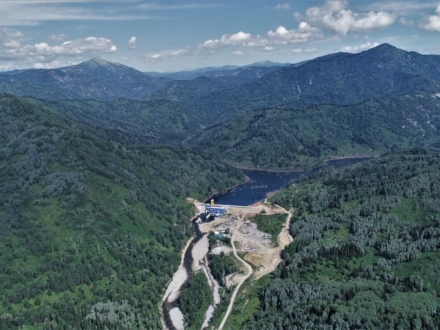
52 Kazakh-Chinese projects
Program History

The Republic of Kazakhstan (RK) is a key Central Asian country for China,
Over 30 years of Kazakhstan-China relations have gone a long way from cross-border trade to a strategic partnership between the countries.

A new stage in the development of bilateral relations was the country's participation in China's Belt and Road Initiative,
that was first announced by Chinese President Xi Jinping in Kazakhstan in the fall of 2013(*).
However, the implementation of the joint program of industrial and investment cooperation within the framework of BRI has generated a lot of rumors and speculations in the country due to the lack of detailed information from the official bodies of Kazakhstan and China. This also concerns the issues of the program’s impact on the environment and environmental rights of the population of Kazakhstan.

The activities of Chinese companies in the country have repeatedly come under scrutiny from the public
A vivid example is the long-standing activity of CNPC-Aktobemunaigas JSC, which is not only one of the leaders of the country’s oil and gas complex, but one of the main polluters in the Aktobe region, where the company produces oil and gas(*).
Therefore, the emergence of a new Kazakh-Chinese industrial development program has caused quite reasonable interest and concerns of the public.
This program was first announced in December 2014, following a meeting of the Shanghai Cooperation Organization. China offered the government of Kazakhstan a project to transfer facilities to the territory of the country. It was about dozens of enterprises in the non-primary sector and multibillion-dollar contracts(*). In August 2015, a Framework Agreement between Kazakhstan and China on strengthening cooperation in industrialization and investment was signed in Beijing(*).

However, the joint program to transfer excess capacity from China failed due to a large number of problems,
The bulk of criticism was related to the environmental risks of imported production facilities. As a result, the program of capacity transfer was transformed into a program of industrial development and opening new production facilities to produce export-oriented products (*).
In August 2016, a cooperation plan was approved between the governments of Kazakhstan and China to link the Nurly Zhol program and the construction of the Silk Road Economic Belt(*).

In September of the same year, the Ministry of Investment and Development of the Republic of Kazakhstan published information about the program of implementation of 51 Kazakh-Chinese projects totaling $26 billion.
At the same time, the ministry emphasized that it is not about relocating existing enterprises from China, but about creating new production facilities using the latest equipment. All projects will have to pass an environmental impact assessment and comply with the country’s environmental standards(*).
As a result, it was decided to implement joint projects in metallurgy, oil and gas processing, chemical industry, mechanical engineering, energy, light industry, agricultural products processing, transportation and logistics(*). However, for a long time, neither the full list of enterprises nor the program of industrial and investment cooperation between Kazakhstan and China was known to the public(*). For a number of years, the government of Kazakhstan and the Chinese embassy in the country gave the most general information about this program without any significant details(*).

The list of projects was constantly changing and was known only to a narrow circle of specialists(*)
All this time, the public was particularly concerned about China’s plans to move excess capacity into the country, especially environmentally dirty enterprises(*). This was one of the reasons for land protests in Kazakhstan in spring 2016(*). The lack of transparency further increased public mistrust of China’s presence and gave rise to various myths and speculations, which led to the rise of Sinophobia in the country(*). The lack of broad and detailed coverage of the program by Kazakh and Chinese government agencies was exploited by opposition-minded citizens of the country.
The protests took place against the backdrop of international condemnation of China’s policy towards ethnic minorities in the Xinjiang Uygur Autonomous Region (*). The government of Kazakhstan had to promptly refute rumors about the relocation of old and dirty factories from China, and explain that the program includes the construction of new plants that meet environmental requirements(*). As a result, thanks to the protests across the country, as well as requests from Kazakhstani media and environmentalists, the country’s government agencies published the most general information on Kazakhstan-China cooperation and a list of relevant projects in September 2019(*)(*). The information was posted on the website of the National Company “KAZAKH INVEST”(*). According to the data published at that time (2019), 55 joint Kazakhstan-China projects worth $27.6 billion were implemented in Kazakhstan in such sectors as: energy 27%, oil and gas chemistry and chemical industry 22%, metallurgy 15%, food industry 9%, machine building 9% and other 18%.

The coronavirus pandemic made adjustments to the pace and scope of project implementation, showing the serious vulnerability and dependence of the program on specialists and equipment from China.
Already in the spring of 2020, under conditions of strict quarantine in the country, the government of Kazakhstan was forced to issue and extend visas to China citizens so that they could participate in the construction of a number of facilities in Zhambyl area(*). The launch of the metallurgical plant in Shymkent was postponed for a year due to the inability of Chinese specialists to enter the country to carry out commissioning work(*). For the same reason, the commissioning of the glass plant in Kyzylorda region was also postponed to 2021(*). In the course of the program implementation, the list of projects and priorities by sectors changed, the main ones being oil and gas chemistry, industry, geology and green energy(*).

As of summer 2022, the program included 52 projects worth $21.1 billion.
From 2015 through July 2022, 20 projects worth $4.453 billion have been launched, 15 projects worth $5.326 billion are under implementation, and 17 projects are under review(*).
In general, assessing the current results of the program implementation compared to the promises of officials about mutually beneficial cooperation, job creation and growth of Kazakhstan’s economy, them are more than modest.
According to local experts, the projects had more of a propaganda effect and most of them were never implemented. Although the program contributed to some diversification of Kazakhstan’s economy(*).
However, the situation with the transparency of the program has not changed dramatically since the fall of 2019. Current information on joint Kazakh-Chinese projects is difficult to find, as it is not allocated in a special section neither on the website of KAZAKH INVEST nor on the website of the Investment Committee of the Ministry of Foreign Affairs of the Republic of Kazakhstan, despite the high public interest in this topic. The updated list of projects, which still contains only the most general information, can be found at the same old 2019 link on the KAZAKH INVEST website(*).

Secrecy of Chinese projects to the public and population continues to be a distinctive feature of almost all Chinese investments in the country.
This can be seen in the response of the Investment Committee of the Ministry of Foreign Affairs of the Republic of Kazakhstan received in June 2022 to a public inquiry regarding the implementation of joint Kazakh-Chinese projects.
Recently in Kazakhstan there has been a growth of anti-Chinese sentiments, which is caused not so much by the increasing presence of China in the country as by the lack of information about planned and realized Chinese projects. It is this that generates rumors and phobias, which are the ground for all sorts of statements by the opposition and public figures. In this case, the state authorities of the country create difficulties for themselves and then heroically overcome them, as it happened in the fall of 2019. The current situation is also a big shortcoming on the part of the authorized bodies of China, which do not interact properly with civil society, non-governmental organizations and the media of the country(*).
This also applies to the environmental aspects of China’s investments in Kazakhstan.

Detailed and public environmental information about the projects could mitigate mistrust of them, and help the country's governmental authorities, together with the public, to address emerging problems
This information resource is a modest attempt of the Initiative Group Eco China Info to contribute to the improvement of environmental transparency of China’s investments in the country.












